These books can also be viewed on a timeline.
Website development reading list
Sustainable Web Design

If you’d never thought that there might be any relationship between the internet and climate change, then this book will open your eyes. In Tom Greenwood’s own words in this book’s first paragraph “if the internet were a country, it would be the sixth most polluting country in the world, with annual emissions similar to Germany”.
Knowing that, one can no longer turn one’s back on the subject. This small book could therefore be the catalyst to transforming how website builders think about the work they do. But fear not: Sustainable Web Design is jam-packed with advice on how to make a website consume less energy. Hardly any aspect of the work that web designers and coders do is neglected.
What also jumps off these pages is that making a site sustainable also makes it faster; what makes a site use less energy also makes it a better experience for the user. This set of inter-connected relationships is made compellingly attractive, if not irresistible, by the author. So do the planet a favour and grab yourself a copy of this book (even in eBook format) and join the movement.
Flexible Typesetting

Who better to guide us through the complexities of website typography than the head of typography at Adobe, Tim Brown? This concise guide does just that. There have been several books on web typography recently but this book approaches the topic from the typesetting perspective, turning web design principles back onto the first principles of text layout and composition. As the author rightly says: “typesetting is the most important part of typography because … it involves preparing text for reading”.
Whilst setting out the technicalities of CSS that relate to typography, we are encouraged to use our judgement based on typesetting good sense. The manner in which the author talks us through that process seems informal - but structured. He introduces notions of pressure and contrast/focus, which work towards establishing a hierarchy of text layout.
There’s a lot in this small volume, maybe too much to introduce into a project in one go. The fundamental approach is of iterative design patterns through repeated revision and evaluation. Happy reading!
Accessibility for Everyone

Another gem of a book from my favourite publisher and this one amply demonstrates that a book-sized refresher course really can get one up-to-speed on recent developments in a specific aspect of web design. Designing websites that are accessible to everyone - irrespective of their specific needs - is hugely important and this book takes the view that everyone benefits from accessible design, even users with no obvious impairments. Yes.
There’s a mass of wisdom and experience in this volume which sheds light on new research, new perspectives and - above all - new resources. If, like me, you last looked at this aspect of web design in detail several years ago, then this will help re-enthuse you about its importance. If you’re new to the subject, there’s perhaps no better read of equivalent brevity.
This is yet another reminder about how many strands of knowledge and understanding are required by solo web designers. An informed and compassionate volume.
The New CSS Layout

I’d recommend this small volume as the best way to leapfrog everything written about CSS in the last ten years. It describes the CSS Grid Layout concept which enables authors to divide layouts into columns and rows using sizing behaviours. Around 70% of the latest browser versions (at November 2017) support these mechanisms so sites can indeed be crafted using them today, with fall-backs scripted up using the CSS supports feature query. The author hand-holds us through this new layout model using simple examples that offer extraordinary power in the simplest possible fashion. Tables went many years ago. This book shows you how to dispense with floats too. Make use of this book to simplify your layout code and save time.
Web Typography

Richard Rutter describes this volume as a handbook but if, like me, you find yourself reading it from cover to cover (instead of dipping into it as a reference book - which you can also do), don’t feel bad about it! This has the authority of Robert Bringhurst’s The Elements of Typographic Style with the web context of Jason Santa Maria’s On Web Typography. It could exist as the only book you’ll ever need to read on web typography - until the next wave of technological change bursts upon us. This is a dazzling book, some ten years in the writing, unabashedly nerdy and pedantic and because of this: authoritative. This will have to be the go-to book on this subject for years to come. It is detailed, wise, lovingly crafted and a joy to leaf through and digest.
Special mention should be made of the book’s ample glossary and bibliographies, of its CSS index, and of its If you read nothing else, read this section, which condenses nearly 300 pages of detail into just over six pages of succinct guidelines. A gem.
Beginning Backdrop CMS
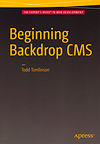
A detailed book that will be of value to those who are not familiar with Drupal. This caters for site-builders who want to install Backdrop and go and for those who want to roll their own code on top of a vanilla Backdrop installation. Just note that some of the authoring links are not from the current version of Backdrop, but these minor differences are navigable. This will help anyone get a Backdrop CMS website up and running.
Pricing Design

A snappy introduction to pricing web projects, especially valuable for beginner freelancers. Replete with insight and specific about different industry pricing models. Take-away nugget: the price you charge for a website is based on the value you are providing to a client. The book’s central case study examines this. From their inexpensive download-only Briefs series by my favourite web design publishers A Book Apart.
Design for Real Life

A fascinating insight into real-life design projects where inadvertent design blunders created stress-points. An unusual book about kindness and compassion in design and one that deserves a place on every designer’s shelf.
Designing for Touch

A detailed examination of the way that our sausage-fat fingers interact with pixels. This is an excellent discussion of the world of rectangular touch screens and the way in which we stretch, crumple, drag, flick aside, point, prod and swipe the pixels that they display. The best read for opening up this particular domain of design challenges - from my favourite publisher.
Migrating from Drupal to Backdrop

This slim volume explains the basics of taking a Drupal 7 site and converting it into a Backdrop CMS site. It covers the fundamental architectural changes required to make D7 themes and modules function within the newer, lighter-weight Backdrop CMS. This is a clean introduction, but it would benefit from screenshots which are readable. (The author, a namesake, is no relation!)
On Web Typography

This is the latest volume from my favourite web industry publisher of “brief books for people who build websites”, A Book Apart, and I can’t resist picking it up and re-reading parts of it. It starts with the reading process itself, moves through to the role played by typography, then covers evaluating typefaces and choosing and pairing them. This is authoritative stuff which is also a good read. Very, very informative.
Web Standards: Mastering HTML5, CSS3 and XML, 2nd edition
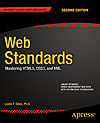
Web standards is a topic that recently seems to have been eclipsed in importance by more fashionable - or pressing - aspects of web design such as UX and responsiveness, so I was interested in seeing what take an Apress book published in 2014 had. Thankfully, the idea that you can - even should - start a project with the aim of the finished code conforming to web standards has not gone away. This volume reiterates this at every turn.
If I were running a course on web technologies, I’d probably include this as a student text. It’s exhaustive, detailed and authoritative. The index, however, could have had more substantial input.
You're My Favorite Client
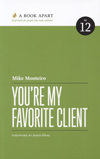
I had to persevere with this volume because it is more applicable to big agencies with big budget web projects, rather than the one-man-band work that I do. That said, there are valuable insights into client-designer relationships here that are applicable across the board. The author takes a novel approach in setting out to guide clients through the site-build process, which can reasonably be described as ‘managing expectations’.
Responsible Responsive Design

This builds on Ethan Marcotte’s seminal Responsive Web Design by looking at the latest options available for delivering lightweight web pages to mobile, plan-constrained, users. It charts a nuanced path between serving pages to latest-generation browsers that support evolving standards and managing this in older ones where graceful fall-backs are required. This is a nice, clear read.
Content Strategy for Mobile

When the client view of your website shrinks, what happens to your content - and what needs to happen? This book addresses these two questions by examining the information architecture issues that have arisen from technological change in website viewing. Essential reading around a complex subject.
Mapping with Drupal - Navigating Complexities to Create Beautiful and Engaging Maps

A clear and authoritative account of the options available for displaying sophisticated and elegant maps that integrate Drupal website content which has a geographical basis. Essential reading for getting Drupal data on the map!
Drupal Search Engine Optimization

An appropriately slim account of how to capitalise on Drupal 7’s already excellent abilities to deliver SEO-maxed websites. A quick summary of a complex subject.
The Elements of Content Strategy

An exceptionally clear examination of the principles of web content publishing and the rational and emotional craft, tools and techniques that can be employed to make a website’s content resonate with users.
Introducing HTML5

A primer by two well-respected developers on some of the new features of HTML and what sort of web-design problems HTML5 can solve right now.
Stunning CSS3 - a project-based guide to the latest in CSS

A clear account of proposed changes to CSS (the style sheet language for websites), which browser supports which proposed property and selector. A well-produced book with clear examples. A good primer on what’s just over the horizon and usable today.
Designing for Emotion

A dream of a book by a well-respected web designer about what makes users ‘fall in love’ with particular websites. Beautifully laid out, the book addresses the role of psychology in website design as a method of connecting to people.
Responsive Web Design

Fluid grids, flexible images and media queries. This is a clearly laid-out approach to the options available for creating sites that are viewable on a range of different devices, from desktop to smart phone to tablet.
This volume has been mentioned in despatches almost more than any other in recent years and is generally acknowledged as being the book that paved the way for ‘responsive web design’. An updated 2nd edition was issued in 2014.
Professional Mobile Web Development with WordPress, Joomla! and Drupal
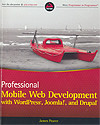
A reasonably clear discussion of using media queries and alternate style sheets (and testing and deployment) so that a website can respond to different devices, specifically in the context of managing this in CMS environments. Worth a spin.
Cognitive Surplus: creativity and generosity in a connected age

Aside from the commercial dimension of the internet, how much of what we surf is there because of talent and goodwill? Wikipedia, for example, represents perhaps a 100 million hours of human thought (compared to the 200 billion hours of TV watched each year in America). This thought-provoking book sheds light on the brighter side of the internet.
Drupal 6 Attachment Views

Bags of detail about the dark heart of Drupal which makes most people fall silent and shake. This is a romp of a manual for doing what I call “intelligent web publishing” with Drupal 6. Splendid!
Drupal 6 Panels Cookbook

Panels is one of the most complex modules avialable for Drupal and this volume steps through various configuration options for unleashing the module’s power and integrating it with other modules.
Drupal e-commerce with Ubercart 2.x

Ubercart is one of Drupal’s most popular e-commerce modules, in use on over 30,000 websites. This volumes details some of the more complex issues relating to setting up a Drupal e-commerce website.
Drupal 6 Performance Tips

All you need to know about Boosting, Throttling, Caching and MemCaching a Drupal website. Great stuff!
Leveraging Drupal: getting your site done right
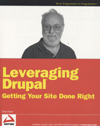
A walk-through of the programming aspects of building a Drupal-driven website.
Drupal 6 Search Engine Optimization

Fine detail for getting the very best in SEO from a Drupal-based website.
Wikinomics: how mass collaboration changes everything

A fascinating analysis of the impact upon society and business of Web 2.0 technologies.
Pro Drupal Development - 2nd edition

All you need to know about the Drupal content management framework - and then some more.
Drupal 6 Themes - create new themes for your Drupal 6 site with clean layout and powerful CSS styling

A theming primer for Drupal-based content management websites.
Building Findable Websites - web standards, SEO and beyond

A primer on what needs to be done to ensure that websites can be found by search engines and - crucially - by making them conform to web standards. This volume yet again confirms that for sites to be successful they need to conform to web standards - as well as being good on the eye.
Building powerful and robust websites with Drupal 6

An excellent introduction to the power and elegance of the Drupal content management framework.
Designing with Web Standards - 2nd edition

Don’t judge this book by the shot of the beanie-hatted author on the cover! Zeldman is amongst the web’s most respected designers and writers and is an evangelist for the development of websites that comply with web standards. This volume makes the convincing case for web standards, including the bottom line of ROI, accessibility and findability/SE-friendliness.
About Face 3 - the essentials of interaction design

A bible for the design of desktop application, Web 2.0 sites and mobile devices.
CSS: The Definitive Guide, 3rd edition

A systematic elaboration on CSS properties and values.
CSS Mastery: Advanced Web Standards Solutions

A primer on the importance of mastering CSS in pursuit of developing standards-compliant websites.
Don't Make me Think! - a common sense approach to web usability

Web page design under the microscope.
Web Copy That Sells: The Revolutionary Formula for Creating Killer Copy Every Time

A wordsmith’s handbook detailing how to write persuasive copy (text) for selling any product or service on the web.
The Zen of CSS Design - visual enlightenment for the web

An outstanding primer on web design and the way in which lean mark-up can deliver stunning visual design. At the time, this was just about the most absorbing book one could hold. A collection of designers had skinned the same HTML code with their own CSS and images, making a dazzling array of web standards compliant site designs. This was a brilliantly simple demonstration of the power and potential of CSS. Anybody unconvinced before opening the book was guaranteed to be a CSS convert at the end. A professional epiphany!
The Inmates are Running the Asylum - why high-tech products drive us crazy and how to restore the sanity

A superb account of what’s missing in the software design process and how to correct it.
The Elements of User Experience - user-centered design for the web

A concise explanation of the obligations placed upon web designers in order to improve user experience on the web.
The Elements of Typographic Style, second edition

The first principle of typographic style, according to Robert Bringhurst, is that “typography exists to honor content”. As the opening shot in this hugely influential book, this sets the tone perfectly. For those of us for whom typography - now (also) on the internet - plays a vital role in shaping web page design, this book lays the foundations in context. Not only is it dense with detail, it is also beautifully-designed.
The Media Equation

Implications for software designers resulting from insights into human-computer interaction.
Visual Interface Design for Windows

Insights into Windows software from Microsoft’s director of visual interface design.
The Design of Everyday Things
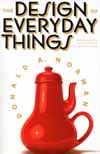
This has nothing to do with software, yet is all about software(!) since it discusses the fundamentals of design and what happens to users when these are missing - this is an enormously important work.
